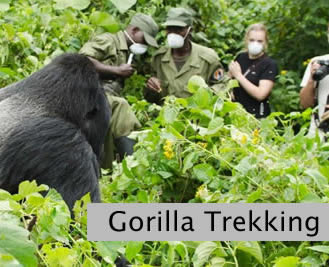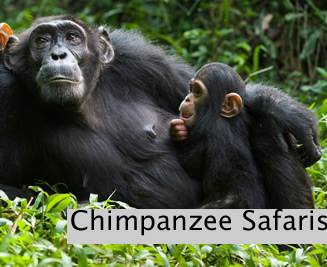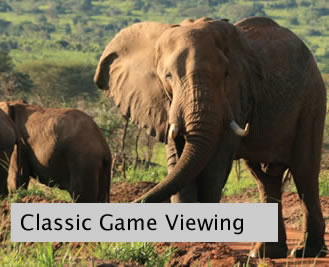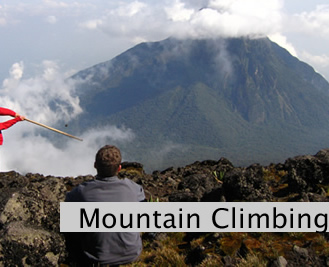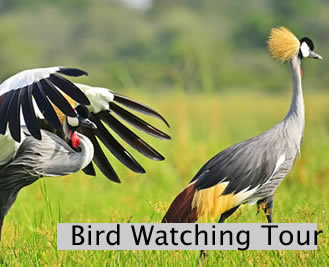Embark on a majestic journey to Queen Elizabeth National Park and get yourself immersed in the wilderness teeming with natural wonders and untamed beauty. Located in western Uganda in Kasese District, Queen Elizabeth National Park is one of the popular travel destinations, the second largest and the most visited National park in the Pearl of Africa. Also known as “A Melody of Wonders”, Queen Elizabeth National Park is Uganda’s most popular and diverse conservation area. Queen Elizabeth National Park enjoys a fabulous setting on the rift valley floor, surrounded by lakes, Escarpments, and the snow-capped Rwenzori Mountains.
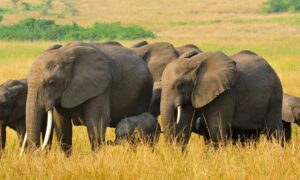 A varied of habitats , including, grassland ,acacia, woodland, forest , wetlands , and open water sustain a wide range of mammals , while the park’s 604 bird species is quite a remarkable tally for protected area covering less than 2000km. Queen Elizabeth National park is a beautiful Park with plenty to see and do on your Uganda safari. The park was founded in 1952 and named to commemorate a visit by the Queen of England. Covering an area of over 700 sq miles between Lakes George and Edward, it is the second largest and most visited park in Uganda.
A varied of habitats , including, grassland ,acacia, woodland, forest , wetlands , and open water sustain a wide range of mammals , while the park’s 604 bird species is quite a remarkable tally for protected area covering less than 2000km. Queen Elizabeth National park is a beautiful Park with plenty to see and do on your Uganda safari. The park was founded in 1952 and named to commemorate a visit by the Queen of England. Covering an area of over 700 sq miles between Lakes George and Edward, it is the second largest and most visited park in Uganda.
The park spans between Kasese, Rubirizi, Rukungiri and Kamwenge districts and it’s an inclusion of QENP, Maramagambo forest, Kyambura gorge bordered by Kigezi game reserve, Kibale Forest and Virunga National Park in the Democratic Republic of Congo. Queen Elizabeth National Park also features the 40 kilometers long Kazinga Channel connecting lakes Edward and George. Superfine Safaris Limited gives you a guide to Queen Elizabeth National Park, about the attractions, where to sleep how to get there and activities in QENP.
Wildlife in Queen Elizabeth National Park
 Like said already, Queen Elizabeth National Park has a high concentration of wildlife, one of the reasons for high tourist visits. The park is home to over 95 mammals and 500 bird species. Animals in Queen Elizabeth National park include African buffalo, Uganda kobs, Nile crocodile, African bush elephant, lions, leopards, Hippotamuse, African leopard, Giant forest hogs, waterbucks, warthogs, and the famous tree-climbing lions in Ishasha sector. Some birds in Queen Elizabeth National park include Long-tailed Cormorants, African Jacana, Fish eagle, Pied Kingfisher, Wattled plovers, Black crake, African fish eagle, egrets, ibises and African kingfisher among others.
Like said already, Queen Elizabeth National Park has a high concentration of wildlife, one of the reasons for high tourist visits. The park is home to over 95 mammals and 500 bird species. Animals in Queen Elizabeth National park include African buffalo, Uganda kobs, Nile crocodile, African bush elephant, lions, leopards, Hippotamuse, African leopard, Giant forest hogs, waterbucks, warthogs, and the famous tree-climbing lions in Ishasha sector. Some birds in Queen Elizabeth National park include Long-tailed Cormorants, African Jacana, Fish eagle, Pied Kingfisher, Wattled plovers, Black crake, African fish eagle, egrets, ibises and African kingfisher among others.
Things to See and Do in Queen Elizabeth National Park
Travelers on Uganda safaris to Queen Elizabeth National Park have an endless list of things to see and do giving them a memorable experience. The top tourist activities in Queen Elizabeth National Park include:
Game Viewing
Go game viewing in the open Savannah’s of Queen Elizabeth National Park for a close encounter with wild animals in the wilderness. Early morning game drives give you a chance to catch up with early risers grazing, browsing, and hunting before retiring for day rest. Expect to see a huge number of wild animals including herds of elephants, buffalos, lions, hippos, Uganda kobs, waterbuck and giant forest hogs among others. Experienced guides help you spot different animals and explain unique features about each spotted animal.
Kazinga channel boat cruise
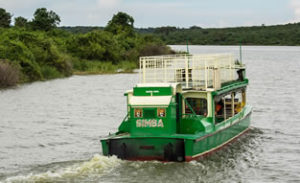
Boat Cruise at Kazinga channel
Join a boat cruise at Kazinga channel for a fresh feeling of cold breezes and great views. The 40 kilometers long Kazinga channel connects Lakes Edward and George. The banks of Kazinga channel is the best spot for bird watching sheltering numerous birds such as saddle-billed stork, African shoebill, Great white, Yellow-billed stork, Pink backed pelicans, African fish eagle, African kingfisher, Ibises, White egrets, yellow billed stork, hammerkops and Africa jacana among others. More so, you will see large crocodiles resting lazily on the riverbanks. Hippos, buffalos, and monitoring lizards are also spotted along Kazinga channel. Kazinga boat cruise is done in the morning at 10:00am and in the afternoon at 2:00pm. Endeavor to keep time.
Chimpanzee trekking in Kyambura Gorge
Go chimpanzee trekking in Kyambura gorge for a magical encounter with man’s closest relatives. The nature walk in this underground forest in search of the endangered chimpanzees is a humbling experience no traveler should miss. Interestingly, chimps in Kyambura gorge do not go far hence short trekking time. Spend an hour in the company of chimpanzees, embrace their human-like characters, take pictures and have fun with your close relatives. The rules and regulations of chimpanzee trekking in Kyambura gorge are similar to those in Kibale Forest Park. They include keeping a distance of seven meters away, avoid direct eye contact, do not use flashlight cameras and speaking at a low tone among others.
Crater lake exploration
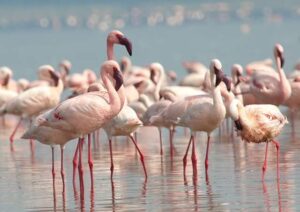 Visit to explore different caret lakes in Queen Elizabeth National park. Each lake is different from the other in terms of activity taking place, history and location. Crater lakes in Queen Elizabeth National park include Katwe crater lake known for salt mining, Lake Munyanyange for flamingoes, Lake Nyamunuka its healing waters, Lake Bunyampaka and Bunyaruguru crater lakes among others.
Visit to explore different caret lakes in Queen Elizabeth National park. Each lake is different from the other in terms of activity taking place, history and location. Crater lakes in Queen Elizabeth National park include Katwe crater lake known for salt mining, Lake Munyanyange for flamingoes, Lake Nyamunuka its healing waters, Lake Bunyampaka and Bunyaruguru crater lakes among others.
Lion tracking
Drive to kasenyi plains for the experimental lion tracking experience. The activity is all about learning in-depth about the kings of the jungle in Queen Elizabeth National Park. You will join a group of rangers and researchers and drive through the kasenyi plains following the directions of radio calls set up in the park. Radio calls trap the movements of lions in the park giving you a direction to take. A 3 Days lion tracking tour gives you the very best of lion tracking experience. Buy a lion-tracking permit at $50 and enjoy this magical experience.
Tree climbing lions
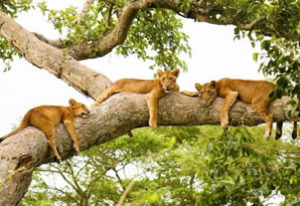
Tree climbing lions in Ishasha
Do not miss visiting to see the famous tree-climbing lions in Ishasha sector south of Queen Elizabeth National park. Keep your eyes up to see lions staring at you from up in the acacia and fig trees. The feeling of looking up to see a lion above your head is magical and memorable. Do not miss it
Accommodation in Queen Elizabeth National Park
Wondering where to sleep in Queen Elizabeth National Park? No worries, a variety of luxury, mid-range and budget lodges and camps have been set up in Queen Elizabeth National park to serve you with first-class food and sleeping services at affordable rates. The top lodges in Queen Elizabeth National park include Mweya Safari Lodge, Ihamba Lakeside Safari Lodge, Enganzi Lodge, Buffalo Safari Lodge, Pumba Safari cottages, Park view Safari Lodge, Katara Lodge, Marafiki Lodge and Simba Safari lodge among others. Superfine Safaris Limited helps you book accommodation services in any lodge of your choice in Queen Elizabeth National Park ensuring your safety, comfort and good stay.
Best time to visit Queen Elizabeth national park
The park can be visited all year round and all activities can be done throughout the year. However during the dry season in the months of June, July, August, September, December, and January, rain is minimal and grass is short which makes game viewing easier. In the wet season, the vegetation is green and sceneries beautiful for photographs.
Getting to Queen Elizabeth National Park
You can get to Queen Elizabeth National park by air or road transport. If you arte using road transport, the park is roughly 3 hours and 30 minutes drive from Kampala via Masaka Mbarara Kasese road. Alternatively, fly from Kajjansi to Kayonza airstrip if you have limited time.
People also ask
What is special about Queen Elizabeth National Park?
Queen Elizabeth National park is known for being the popular and most visited park in Uganda. The park shelters abundant wildlife which comprise of 95 mammals and over 600 bird species. The popular activities done in Queen Elizabeth National park include game viewing, bird watching, boat cruising, salt mining, nature walks and camping among others
How Many lions are in Queen Elizabeth National Park?
Roughly 130 lions are recorded in Queen Elizabeth National park. These are seen roaming in the plains of Kasenyi and Ishasha where tree climbing lions live up in the acacia and fig trees. Uganda as a whole has over 400 lions which are scattered in different savannahs Parks especially Queen Elizabeth, Murchison Falls and Kidepo Valley National park.
How much does Queen Elizabeth National park cost?
The cost of visiting Queen Elizabeth National park is determined by many factors. These include the activities to do and how long one is spending in the park. The cost include $40 park entrance fee, $30 for boat cruise at Kazinga Channel, $10 vehicle entrance, $50 chimpanzee trekking in Kyambura gorge
What is the big five in Queen Elizabeth National Park?
Queen Elizabeth National Park is home to the big four “Lions, Elephants, Leopards and Hippos”. Rhinos are absent in Queen Elizabeth National park but can be seen at Zziwa Rhino sanctuary in Nakasongola. In addition to the big four, Queen Elizabeth shelters several other wild animals which include Uganda kobs, Waterbucks, Warthogs, Gazelles and Topis among others
Conclusively, Queen Elizabeth National Park is your ultimate Uganda safari destination. Enjoy game viewing, boat cruise, and chimpanzee trekking in Queen Elizabeth National park with Superfine Safaris Limited

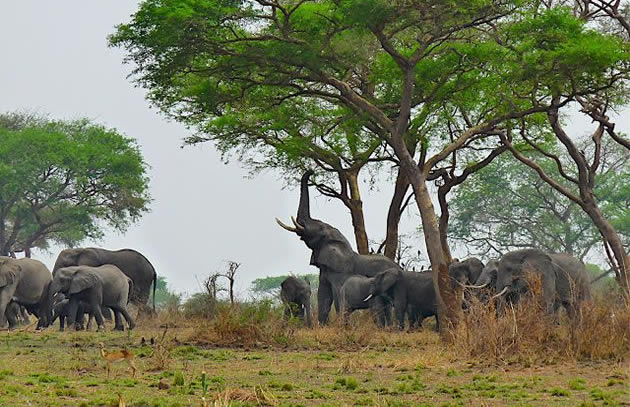
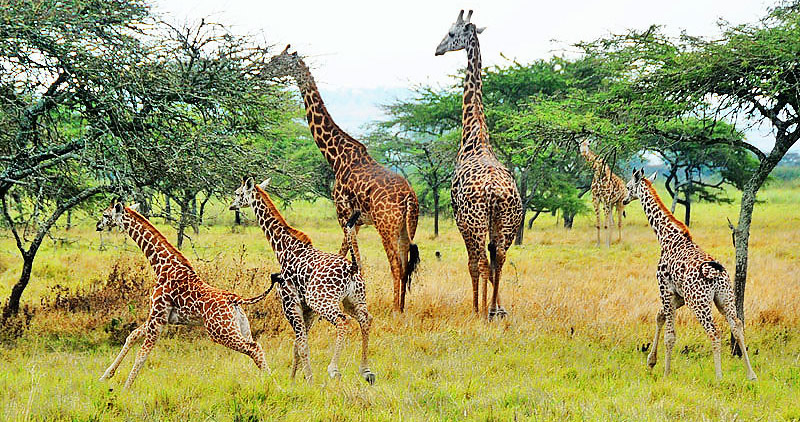
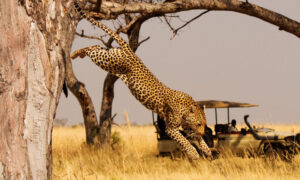
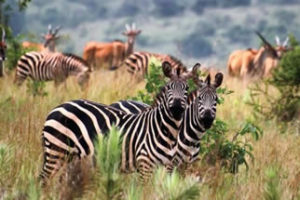 This is the number one tourist activity in Akagera National park on your Rwanda tours. Bing home to the big five game, Akagera game park gives travelers with a memorable game viewing experience, a close encounter with numerous animals in their natural habitats.
This is the number one tourist activity in Akagera National park on your Rwanda tours. Bing home to the big five game, Akagera game park gives travelers with a memorable game viewing experience, a close encounter with numerous animals in their natural habitats.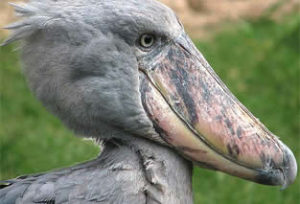
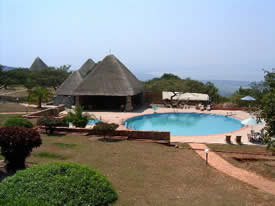
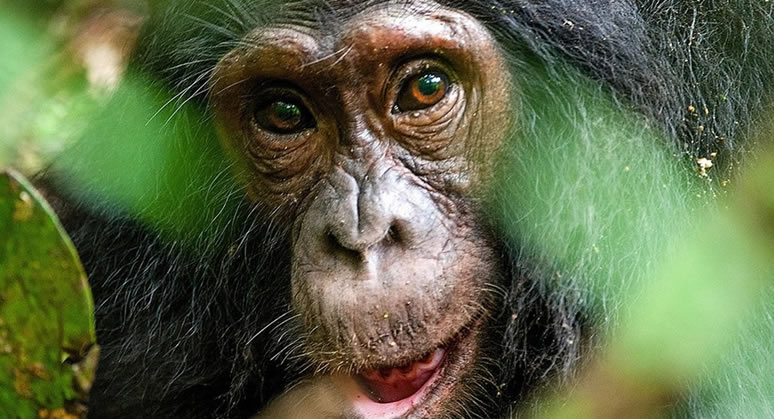
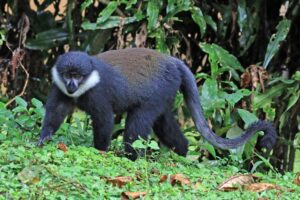 Chimpanzees are the common species in the park with over 1500 chimpanzees calling this forest home. Other primate species in Kibale Forest include Uganda Mangabey (Lophocebus), L;Hoest monkey and Ugandan red colubus (Procolobus tephrosceles), black and white colubus (Colobus guereza), blue monkey (Cercepithecus mitis). Besides primates, Kibale Forest shelters a large number of terrestrial mammals which include bushbucks, bushpigs, red duikers, Sitatungas, Blue duikers, Common warthogs, African buffalos, elephants and Giant forest hogs, common warthogs. The carnivores in this forest are serval cats, leopards, and African golden cats.
Chimpanzees are the common species in the park with over 1500 chimpanzees calling this forest home. Other primate species in Kibale Forest include Uganda Mangabey (Lophocebus), L;Hoest monkey and Ugandan red colubus (Procolobus tephrosceles), black and white colubus (Colobus guereza), blue monkey (Cercepithecus mitis). Besides primates, Kibale Forest shelters a large number of terrestrial mammals which include bushbucks, bushpigs, red duikers, Sitatungas, Blue duikers, Common warthogs, African buffalos, elephants and Giant forest hogs, common warthogs. The carnivores in this forest are serval cats, leopards, and African golden cats.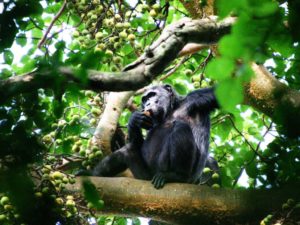 Chimpanzee trekking in Kibale Forest is the most done adventure which bring a high number of travelers to this forest. Records indicate that over 80% of travelers to Kibale forest choose to trek chimpanzees for a close encounter with man’s close relatives. Each chimpanzee permits in the Kibale forest costs $250 but the experience is worth it. Like in gorilla trekking, travelers intending to trek chimps are advised to book as early as 6 months in advance due to high demand for the permit. Chimpanzee trekking in Kibale forest is done in two sessions (morning and afternoon) to give all travelers a chance of being part of this memorable venture.
Chimpanzee trekking in Kibale Forest is the most done adventure which bring a high number of travelers to this forest. Records indicate that over 80% of travelers to Kibale forest choose to trek chimpanzees for a close encounter with man’s close relatives. Each chimpanzee permits in the Kibale forest costs $250 but the experience is worth it. Like in gorilla trekking, travelers intending to trek chimps are advised to book as early as 6 months in advance due to high demand for the permit. Chimpanzee trekking in Kibale forest is done in two sessions (morning and afternoon) to give all travelers a chance of being part of this memorable venture.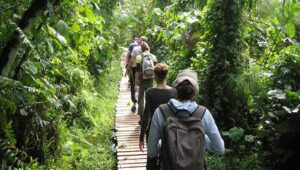 Explore and enjoy the beauties of Kibale Forest National park on foot. A walk through the natural forest, enjoy the cool quiet environment with sweet melodies of birds singing right above our head. A forest walk gives you the chance to meet different forest animals especially the red-tailed monkeys, black and white Colubus. Expect to see some reptiles such as snakes and birds crossing across. Different trails have been made in the forest leading you to different tourist attractions such as waterfalls and water streams. Also, night forest walk is done to see nocturnal animals such as nightjar, cricket, pottos, bush babies and tree hyrax among others.
Explore and enjoy the beauties of Kibale Forest National park on foot. A walk through the natural forest, enjoy the cool quiet environment with sweet melodies of birds singing right above our head. A forest walk gives you the chance to meet different forest animals especially the red-tailed monkeys, black and white Colubus. Expect to see some reptiles such as snakes and birds crossing across. Different trails have been made in the forest leading you to different tourist attractions such as waterfalls and water streams. Also, night forest walk is done to see nocturnal animals such as nightjar, cricket, pottos, bush babies and tree hyrax among others.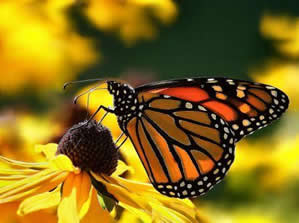 Be part of the newly introduced butterfly watching experience in Kibale Forest National park. You will see butterflies of different colors in Yellow, red and green flying over you. Altogether, Uganda is home to over 1,235 butterfly species and 31 of these are endemic to the Albertine region. Butterfly species in Uganda include Nymphalidae, Papilinidae, Pieridae, Hesperiidae and Lycaenidae among others.
Be part of the newly introduced butterfly watching experience in Kibale Forest National park. You will see butterflies of different colors in Yellow, red and green flying over you. Altogether, Uganda is home to over 1,235 butterfly species and 31 of these are endemic to the Albertine region. Butterfly species in Uganda include Nymphalidae, Papilinidae, Pieridae, Hesperiidae and Lycaenidae among others.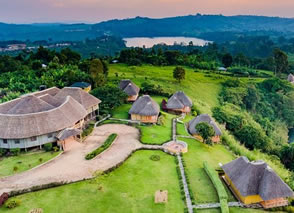 Do you want to spend an overnight stay? African Apes Tours & Travel brings you a list of top lodges and camps in Kibale Forest. These serve you with first-class food and sleeping services with professional staff who ensure a smooth service delivery system. Top lodge sin Kibale forest include Primate Lodge, Crater Safari Lodge, Kibale Forest Camp, Kyaninga Lodge, Papaya Lake Lodge, Chimpanzee Forest guest house, Ndali Lodge, Chimpanzee Forest Guesthouse and Chimps Nest among others. African Apes Holidays helps book suitable accommodation services during your stay in Kibale Forest National Park.
Do you want to spend an overnight stay? African Apes Tours & Travel brings you a list of top lodges and camps in Kibale Forest. These serve you with first-class food and sleeping services with professional staff who ensure a smooth service delivery system. Top lodge sin Kibale forest include Primate Lodge, Crater Safari Lodge, Kibale Forest Camp, Kyaninga Lodge, Papaya Lake Lodge, Chimpanzee Forest guest house, Ndali Lodge, Chimpanzee Forest Guesthouse and Chimps Nest among others. African Apes Holidays helps book suitable accommodation services during your stay in Kibale Forest National Park.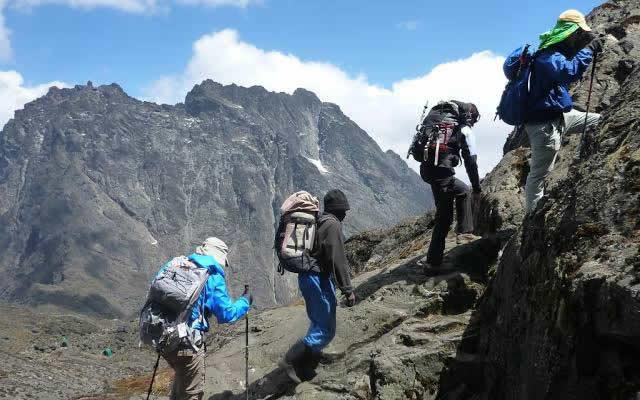
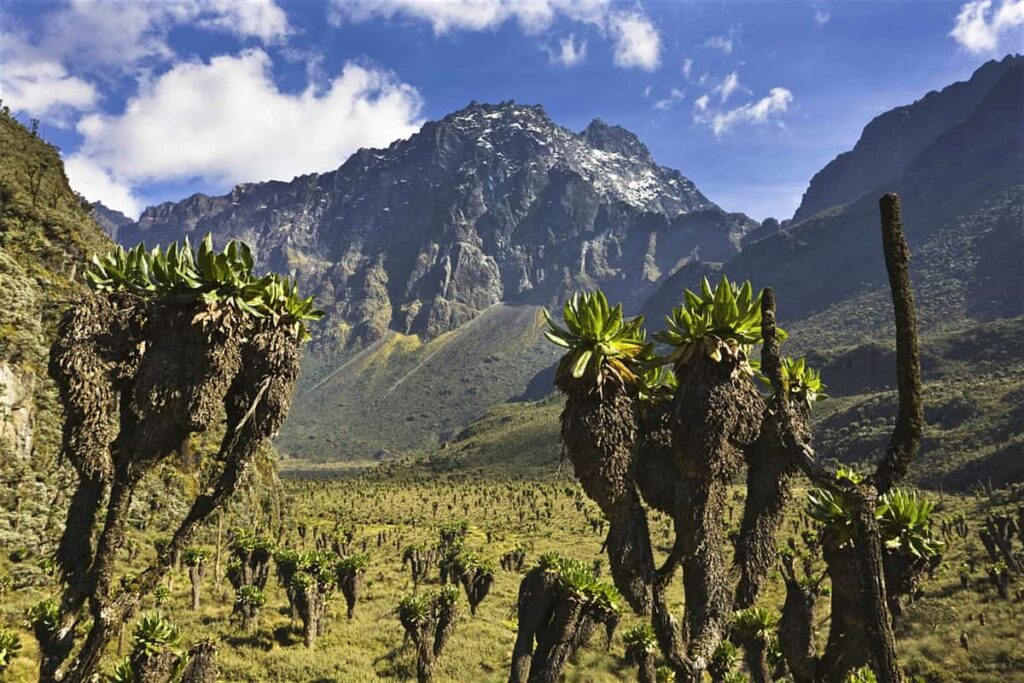 Hike using the central circuit route managed by Rwenzori Mountaineering services. The central circuit route is the oldest and main route, which the first climbers to Margherita peak used. The trail starts from Nyakalengija village at the National park headquarters sloping down to Mt Baker.
Hike using the central circuit route managed by Rwenzori Mountaineering services. The central circuit route is the oldest and main route, which the first climbers to Margherita peak used. The trail starts from Nyakalengija village at the National park headquarters sloping down to Mt Baker.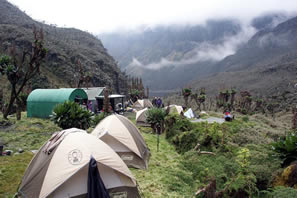
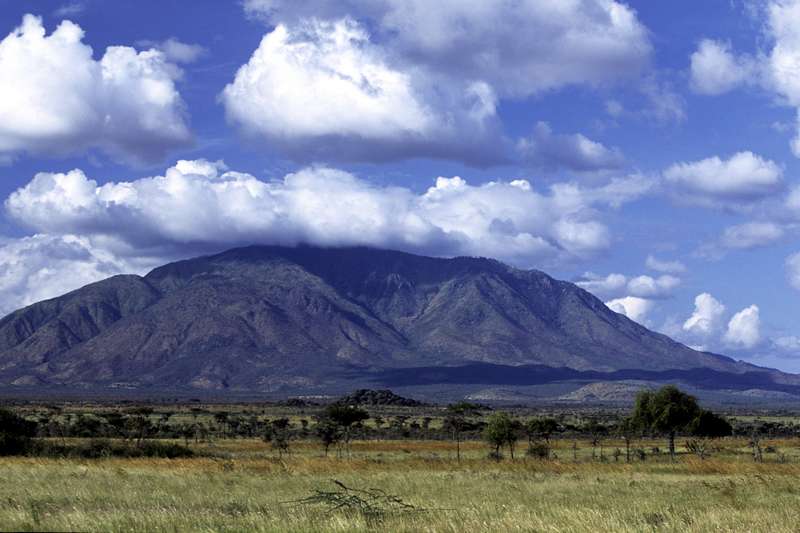 Located in eastern Uganda in the borders of Uganda and kenya,
Located in eastern Uganda in the borders of Uganda and kenya, 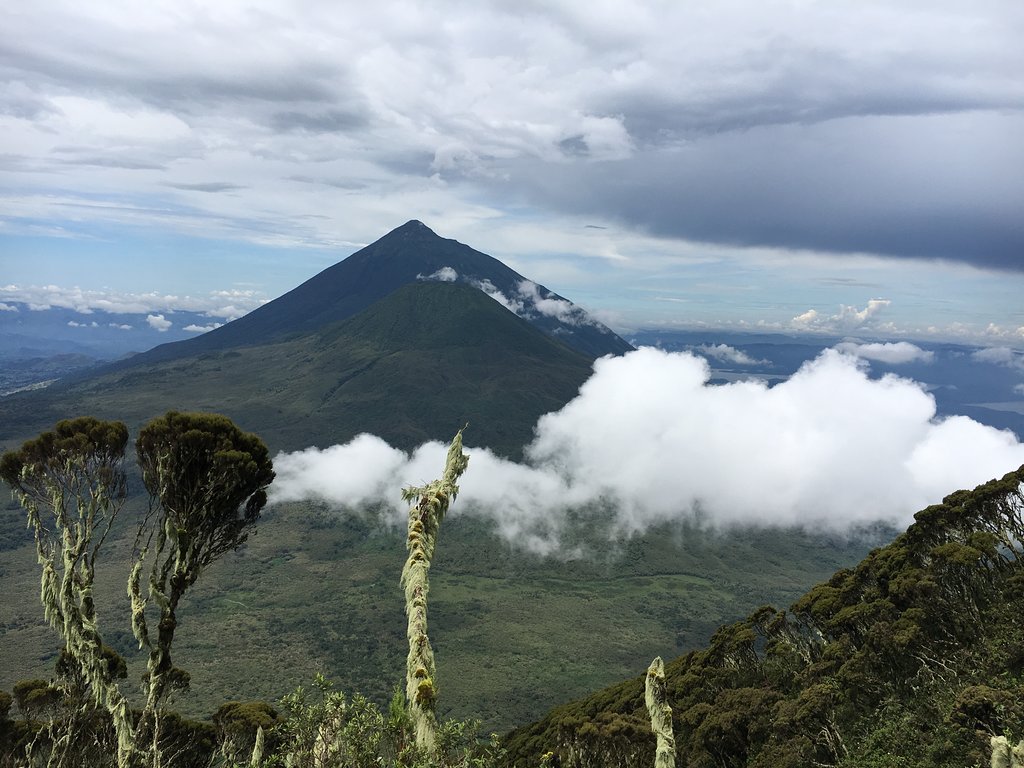 Also fond in Mgahinga gorilla National park, Mount Sabyinyo stands at3,669 meters above sea level located in the borders of Uganda, Rwanda and teg Democratic Republic of Congo. This means that the Volcano can be hiked from any of the three countries. However, the peak is located in Uganda. The name Sabyinyo is a local Kinyarwada word which means old man’s tooth. The slopes of the Volcano shelters the endangered mountain gorillas, golden monkeys and various bird species. Sabyinyo is the oldest Volcano in the Virunga conservation Area
Also fond in Mgahinga gorilla National park, Mount Sabyinyo stands at3,669 meters above sea level located in the borders of Uganda, Rwanda and teg Democratic Republic of Congo. This means that the Volcano can be hiked from any of the three countries. However, the peak is located in Uganda. The name Sabyinyo is a local Kinyarwada word which means old man’s tooth. The slopes of the Volcano shelters the endangered mountain gorillas, golden monkeys and various bird species. Sabyinyo is the oldest Volcano in the Virunga conservation Area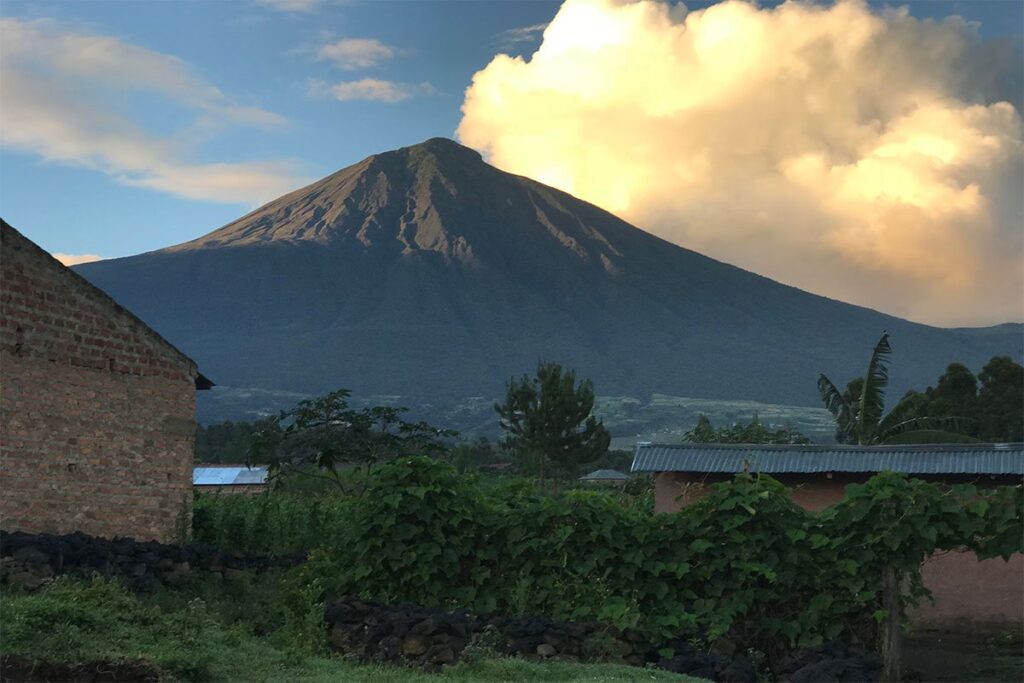 Standing at 4127 meters above sea level,
Standing at 4127 meters above sea level, 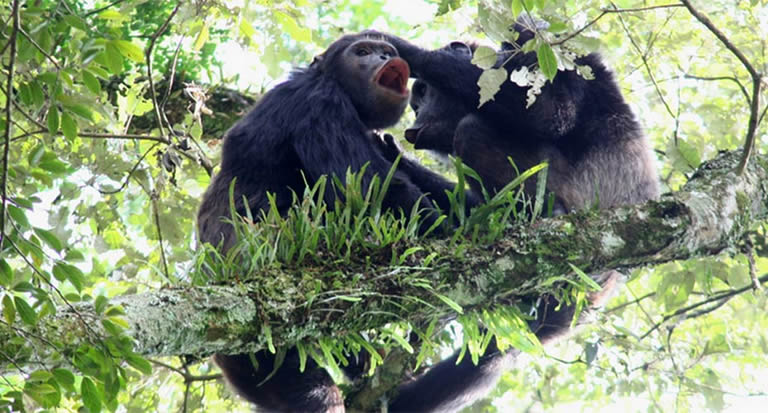
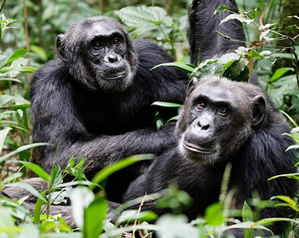
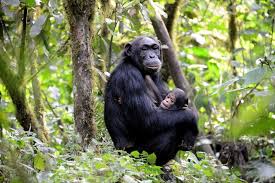
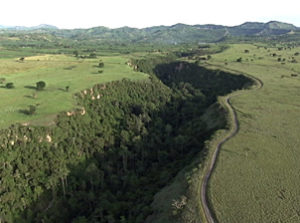
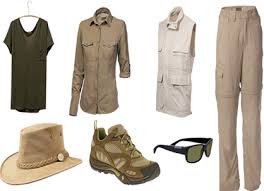 Make sure you pack the essentials to make your chimpanzee tour a success and fun. The chimpanzee trekking packing list includes:
Make sure you pack the essentials to make your chimpanzee tour a success and fun. The chimpanzee trekking packing list includes: